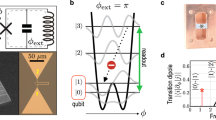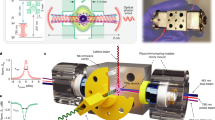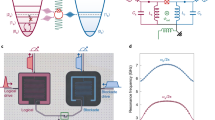Abstract
Solid-state superconducting circuits1,2,3 are versatile systems in which quantum states can be engineered and controlled. Recent progress in this area has opened up exciting possibilities for exploring fundamental physics as well as applications in quantum information technology; in a series of experiments4,5,6,7,8 it was shown that such circuits can be exploited to generate quantum optical phenomena, by designing superconducting elements as artificial atoms that are coupled coherently to the photon field of a resonator. Here we demonstrate a lasing effect with a single artificial atom—a Josephson-junction charge qubit9—embedded in a superconducting resonator. We make use of one of the properties of solid-state artificial atoms, namely that they are strongly and controllably coupled to the resonator modes. The device is essentially different from existing lasers and masers; one and the same artificial atom excited by current injection produces many photons.
This is a preview of subscription content, access via your institution
Access options
Subscribe to this journal
Receive 51 print issues and online access
$199.00 per year
only $3.90 per issue
Buy this article
- Purchase on Springer Link
- Instant access to full article PDF
Prices may be subject to local taxes which are calculated during checkout



Similar content being viewed by others
References
Makhlin, Y., Schön, G. & Shnirman, A. Quantum-state engineering with Josephson-junction devices. Rev. Mod. Phys. 73, 357–400 (2001)
Devoret, M. H., Wallraff, A. & Martinis, J. M. Superconducting qubits: A short review. Preprint at 〈http://arxiv.org/abs/cond-mat/cond-mat/0411174〉 (2004)
Wendin, G. & Shumeiko, V. S. in Handbook of Theoretical and Computational Nanotechnology Vol. 3 (eds Rieth, M. & Schommers, W.) 223–309 (American Scientific Publishers, Los Angeles, 2006)
Wallraff, A. et al. Strong coupling of a single photon to a superconducting qubit using circuit quantum electrodynamics. Nature 431, 162–167 (2004)
Chiorescu, I. et al. Coherent dynamics of a flux qubit coupled to a harmonic oscillator. Nature 431, 159–161 (2004)
Johansson, J. et al. Vacuum Rabi oscillations in a macroscopic superconducting qubit LC oscillator system. Phys. Rev. Lett. 96, 127006 (2006)
Schuster, D. I. et al. Resolving photon number states in a superconducting circuit. Nature 445, 515–518 (2007)
Houck, A. A. et al. Generating single microwave photons in a circuit. Preprint at 〈http://arxiv.org/abs/cond-mat/0702648〉 (2007)
Nakamura, Y., Pashkin & Tsai, J. S. Coherent control of macroscopic quantum states in a single-Cooper-pair box. Nature 398, 786–788 (1999)
Raimond, J.-M., Brune, M. & Haroche, S. Manipulating quantum entanglement with atoms and photons in a cavity. Rev. Mod. Phys. 73, 565–582 (2001)
Mabuchi, H. & Doherty, A. Cavity quantum electrodynamics: Coherence in context. Science 298, 1372–1377 (2002)
Walther, H. et al. Cavity quantum electrodynamics. Rep. Prog. Phys. 69, 1325–1382 (2006)
McKeever, J., Boca, A., Boozer, A. D., Buck, J. R. & Kimble, H. J. Experimental realization of a one-atom laser in the regime of strong coupling. Nature 425, 268–271 (2003)
Reithmaier, J. P. et al. Strong coupling in a single quantum dot-semiconductor microcavity system. Nature 432, 197–200 (2004)
Yoshie, T. et al. Vacuum Rabi splitting with a single quantum dot in a photonic crystal nanocavity. Nature 432, 200–203 (2004)
Rice, P. R. & Carmichael, H. J. Photon statistics of a cavity-QED laser: A comment on the laser-phase transition analogy. Phys. Rev. A 50, 4318–4329 (1994)
Mu, Y. & Savage, C. M. One-atom lasers. Phys. Rev. A 46, 5944–5954 (1992)
Rodrigues, D. A., Imbers, J. & Armour, A. D. Quantum dynamics of a resonator driven by a superconducting single-electron transistor: A solid-state analogue of the micromaser. Phys. Rev. Lett. 98, 067204 (2007)
You, J. Q., Liu, Y. X., Sun, C. P. & Nori, F. Persistent single-photon production by tunable on-chip micromaser with a superconducting qubit circuit. Phys. Rev. B 75, 104516 (2007)
Hauss, J., Fedorov, A., Hutter, C., Shnirman, A. & Schön, G. Single-qubit lasing and cooling at the Rabi frequency. Preprint at 〈http://arxiv.org/abs/cond-mat/0701041〉 (2007)
Averin, D. V. & Aleshkin, V. Ya. Resonance tunneling of Cooper pairs in a system of small Josephson junctions. JETP Lett. 50, 367–369 (1989)
Fulton, T. A., Gammel, P. L., Bishop, D. J., Dunkleberger, L. N. & Dolan, G. J. Observation of combined Josephson and charging effects in small tunnel junction circuits. Phys. Rev. Lett. 63, 1307–1310 (1989)
Siegman, A. E. Lasers (University Science Books, Mill Valley, 1986)
Acknowledgements
We are grateful to A. Zagoskin, A. Smirnov, L. Murokh, S. Kouno, A. Tomita and A. Clerk for discussions.
Author information
Authors and Affiliations
Corresponding author
Ethics declarations
Competing interests
The authors declare no competing financial interests.
Rights and permissions
About this article
Cite this article
Astafiev, O., Inomata, K., Niskanen, A. et al. Single artificial-atom lasing. Nature 449, 588–590 (2007). https://doi.org/10.1038/nature06141
Received:
Accepted:
Published:
Issue Date:
DOI: https://doi.org/10.1038/nature06141
This article is cited by
-
Circuit quantum electrodynamics with dressed states of a superconducting artificial atom
Scientific Reports (2022)
-
A low-noise on-chip coherent microwave source
Nature Electronics (2021)
-
Proposal for a continuous wave laser with linewidth well below the standard quantum limit
Nature Communications (2021)
-
Energy-level quantization and single-photon control of phase slips in YBa2Cu3O7–x nanowires
Nature Communications (2020)
-
Two Quantum Coins Sharing a Walker
International Journal of Theoretical Physics (2019)
Comments
By submitting a comment you agree to abide by our Terms and Community Guidelines. If you find something abusive or that does not comply with our terms or guidelines please flag it as inappropriate.



